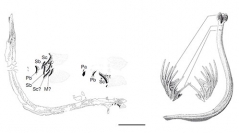

 Geodiversitas
32 (4) - Pages 545-594
Geodiversitas
32 (4) - Pages 545-594An evidence-based reassessment of the phylogenetic relationships of conodonts shows that they are not “stem” gnathostomes, nor vertebrates, and not even craniates. A significant group of conodont workers have proposed or accepted a craniate designation for the conodont animal, an interpretation that is increasingly becoming established as accepted “fact”. Against this prevailing trend, our conclusion is based on a revised analysis of traditional morphological features of both discrete conodont elements and apparatuses, histological investigation and a revised cladistic analysis modifying that used in the keystone publication promoted as proof of the hypothesis that conodonts are vertebrates. Our study suggests that conodonts possibly were not even chordates but demonstration of this is beyond the scope of this paper. To summarize, in conodonts there is low cephalization; presence of simple V-shaped trunk musculature and unique large-crystal albid material in the elements; lack of a dermal skeleton including characteristic vertebrate hard tissues of bone, dentine and enamel; lack of odontodes with bone of attachment and a unique pulp system; lack of segmentally-arranged paraxial elements and dermal elements in median fins, all of which supports neither a vertebrate nor a craniate relationship for conodonts.
Chordata, Craniata, conodont animals/ elements, character coding, cladistic analysis, palaeo-histology